Summary :
◉ Introduction
Bacterial physiology consists in studying the nutrition, metabolism and growth of bacteria according to variations (natural or controlled) in the environment in which they live.
❖ Bacterial nutrition:
it is the analysis of the elementary, energetic and specific needs necessary for the functioning and growth of the bacterium, as well as the physico-chemical factors likely to influence them.
❖ Bacterial biochemical metabolism:
It is the set of chemical transformations (anabolism or biosynthesis and catabolism or degradation) that ensure the development of bacterial constituents and their functioning.
❖ Bacterial growth:
In an optimal environment, the bacterial cell, thanks to its highly developed enzymatic system, will give birth in a short time (20 minutes for the majority of bacteria in the environment), to two daughter bacteria that are identical to it: We are talking about bacterial growth. It is manifested by a numerical increase in bacterial cells and not an increase in size as in higher organisms (Human, animal, plant).
◉ Nutrition and bacterial growth
A- Nutrition :
To survive and multiply, bacteria need a greater or lesser quantity of mineral and organic substances called food substances or nutrients.

The degradation of these foods, which are made available to them in culture media, will provide them with simple elements (Carbon, Nitrogen, Minerals) and energy, which they will reuse to synthesize their own structural and enzymatic constituents.
Bacteria all have a certain number of common needs such as: water, a source of energy, a source of Carbon, a source of Nitrogen and mineral elements. Moreover, by examining the chemical composition of the bacterial cell, we can guess its nutritional needs:
- The bacterium is made up mostly of water: 75 to 80% of its total weight.
- The dry matter is made up of proteins (55%), rRNA (16.7%), tRNA (3%), mRNA (0.8%), DNA (3.1%), lipids (9.1 %), Lipopolysaccharides (3.4%), Peptidoglycans (2.5%), vitamins (2.9%) and inorganic ions (1.0%).
❖ Therefore, the bacteria will need 3 types of nutrients:
- 1. Basic and energy needs
- 2. Specific needs
- 3- Physical factors
1. Basic and energy needs :
1-a- Basic needs:
❖ Water: A major need, it is part of the composition of all growing media.
❖ Carbon: This is one of the most abundant elements in bacteria: it must be provided in sufficient quantity. The simplest carbon compound is CO2 or carbon dioxide. Bacteria are classified into 2 categories:
- Autotrophic Bacteria: Those capable of growing in an inorganic medium containing CO2 as the only source of Carbon
- Heterotrophic Bacteria: These bacteria are capable of degrading a range of hydrocarbon substances: Alcohol, acetic acid, lactic acid (simple molecules), polysaccharides (complexes).
❖ Nitrogen: Nitrogenous substances are part of the composition of bacterial proteins. Nitrogen can be fixed by bacteria :
- In the form of molecular nitrogen, i.e. the simplest form. ex. Rhizobium – Azotobacter and certain Clostridia.
- In the form of inorganic compounds: Ex. Nitrite by Nitrobacter Ammonia in the form of ammonium salts by Nitrosomonas
- In the form of organic compounds R-NH2 whose amino groups represent the source of nitrogen.
❖ Phosphorus and Sulfur: They occupy a place of choice.
❖ Phosphorus :
It enters into the composition of nucleic acids, many coenzymes and ATP. It is incorporated into the bacteria in the form of inorganic phosphate. It allows the recovery, accumulation and distribution of energy in the cell.
❖Sulfur :
Il entre dans la composition des acides aminés et des
proteins (thiol group). It is incorporated into the cell as sulfate, organic sulfur compounds, rarely as reduced sulfur.
❖O2 and H2: are brought by water and atmospheric air. The elements mentioned must be provided in sufficient quantities.
❖ In smaller quantities are provided the mineral elements :
- ● Some are involved in the physico-chemical balance of the cell: Na, K, Mg and Cl.
- ● Others constitute enzymes or coenzymes: Cytochrome iron.
❖ In trace amounts, often brought by water: These are the trace elements because they are essential in minute quantities: These are Ca, Mg, Co, Cu, Mn….
It should be noted that many metal ions can be toxic for certain cells (ex: copper salts) whereas other ions are essential at precise concentrations, either for the synthesis of a metabolite (ex: 0.14 mg of Fe/ l for the synthesis of diphtheria toxin), or for the synthesis of pigment (eg: Iron + Magnesium for the production of Prodigiosine in Serratia marcescens).
1-b- Energy needs
❖ They cover the expenses incurred in the biosynthetic processes. Bacteria can use as an energy source:
- Either light energy (phototrophic bacteria), which transform light photons into ADP~Pi bond
- Either the energy provided by oxidation-reduction processes (chemotrophic bacteria)
❖ Phototrophic bacteria use mineral or organic compounds as sources of electrons.
- If the oxidizable substrate is mineral, the bacterium is said to be photo-lithotrophic: it is capable of developing in a purely mineral environment as plants do: for example, purple or green sulfur bacteria.
- If the oxidizable substrate is organic, the bacterium is said to be photo-organotrophic: example non-sulphurous purple bacteria.
❖ Chemotrophic bacteria, which draw their energy from redox reactions, use mineral or organic compounds as "hydrogen or electron donors" or "electron acceptors".
- If the electron donor is a mineral body, the bacterium is said to be chemolithotrophic, an example of a bacterium that oxidizes hydrogen.
- If the compound is organic, the bacterium is said to be chemoorganotrophic. The vast majority of bacteria fall into this last category: pathogenic bacteria of medical interest, food contamination, industrial use for the synthesis of vitamin antibiotics
2. Specific needs:
❖ These are essential metabolites that the bacterium is not able to synthesize by enzymatic defect and that must therefore be provided to allow its development. They are called Growth Factors.
❖ Bacteria are therefore classified into 2 categories:
- Prototrophs that do not require growth factor (e.g. E.coli)
- Auxotrophs that require them (e.g. Haemophilus influenzae).
- the need can help in the diagnosis by practicing the test of satellitism.
3- Physical factors :
❖ They play an essential role in obtaining an optimal culture. Indeed, the nutrients must be provided to the bacterium in the environmental conditions that suit it, otherwise, they can inhibit it.
a- Temperature: Depending on the behavior of the bacteria with respect to temperature, we distinguish :
- Mesophilic bacteria: whose optimum growth temperature is between 20°C and 40°C. 30°C is generally accepted for saprophytic mesophiles, 37°C for pathogenic mesophiles. The majority of microorganisms in humans and animals are mesophiles: Pathogenic bacteria, bacteria in natural cavities or in the human skin and mucosal covering….
- Thermophilic bacteria: the optimum temperature is 45°C to 65°C, usually 55°C. These are the hot springs bacteria. ex: Bacillus and Clostridium.
- Psychrophilic bacteria: whose optimum temperature is around 0°C. In this category, we can place the Psychrotrophic bacteria which grow abundantly at refrigeration temperatures but which multiply even more at 10°C or 20°C. These bacteria often contaminate dairy products, as well as biological products (blood or blood derivatives) stored at low temperature .ex .Pseudomonas, Acinetobacter, Aeromonas.
- Cryophilic bacteria: which prefer temperatures below 0°C: These are the bacteria of the oceans and glaciers.

b- The pH : Bacteria prefer a neutral or slightly alkaline pH (7 –7.5) but the limits are very wide :
- E.coli grows between pH 4.4 and pH8
- Lactobacilli rather require a low pH, close to 6 (L.acidophilus)
- Vibrion multiplies at the optimum pH of 9
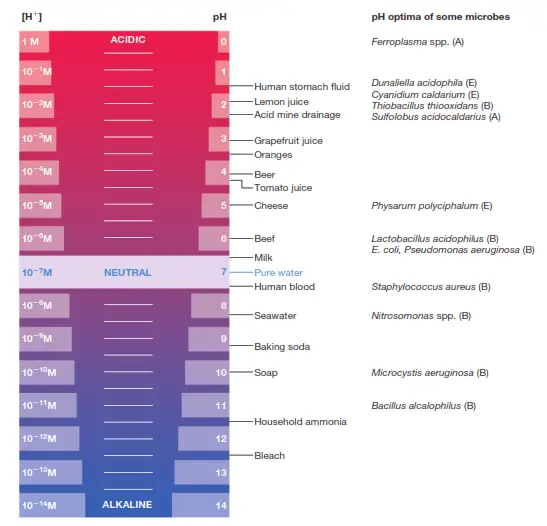
c- Oxygen : Depending on the respiratory type, we distinguish :
- Strict aerobic bacteria: can only live in the presence of oxygen in the air and tolerate high PO2. ex. BK , B.pyocyanic , surface culture only.
- Strict anaerobic bacteria: do not tolerate O2 which is toxic to them e.g. Bacteroides fragilis. Culture only at the bottom of the tube.
- Facultative aero-anaerobic bacteria: grow both in the presence and in the absence of oxygen. Their enzymatic richness allows them to use O2 if it is present and to use the fermentation route when oxygen is absent. ex. Enterobacteriaceae
- Microaerophilic bacteria: reproduce only in the presence of low oxygen tension. ex. Campylobacter
- Aero-tolerant anaerobic bacteria: Although they tolerate oxygen, they cannot use it and derive their energy exclusively from fermentation. ex. Lactobacilli
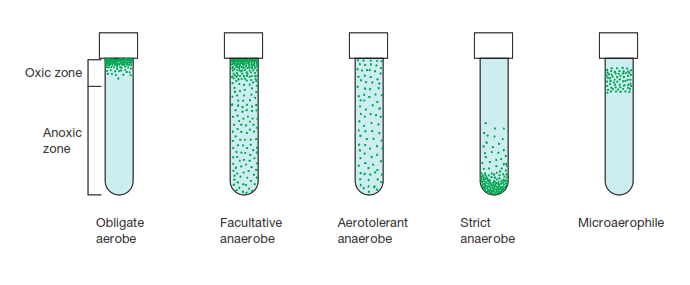
d- Osmotic pressure: Thanks to a specific wall of prokaryotes (Murein) which gives them rigidity and resistance to shocks, bacteria tolerate variations in ionic concentrations. Some bacteria tolerate high salt concentrations eg. Enterococcus (6.5%Nacl) Staphylococcus aureus (7.5%Nacl).
B- Bacterial growth :
1- Definition
It is the orderly growth of all the components of an organism. If, in higher organisms, it results in an increase in size, in unicellular organisms (bacteria, yeasts), it results in an increase in the number of individuals.
There is therefore a multiplication, approximately every 30 minutes, of a bacterium, giving rise by division to 2 new identical bacteria.
Generation time is defined as the time required for a doubling of the number of bacteria. ex. E.coli: TG = 20mn, M.tuberculosis: TG = 20h. Growth rate is also defined as the number of divisions per unit time (eg 3 for E.coli).
During growth, the environment becomes depleted in available nutrients and enriched in products of catabolism, which are often toxic. Changes occur there, affecting the pH, the Redox potential, the osmotic pressure, etc.
2- Techniques for measuring bacterial growth :
a- Direct counting of bacteria : bacteria are considered as Particles that are counted fresh or after staining.
a-1- Total count: for this we use :
- Microscopic examination using a hematimetric cell: all living and dead bacteria are counted.
- Automated measurement with a particle counter of bacteria suspended in an electrolyte solution: both bacteria and inert particles of the same size are counted.
- The epifluorescence method: Bacteria are stained with a flurochrome: Acridine orange is currently the most commonly used and stains in fluorescent red bacteria in the process of growth or dead cells carrying degenerated DNA. On the other hand, Acridine orange stains inactive bacteria containing double-stranded DNA in fluorescent green. This staining therefore allows the counting of all bacterial cells (total bacteria) without distinguishing between living and dead.
a-2- Viable cell count :
- Cultivable bacteria form colonies on an appropriate culture medium: culture is used in Petri dishes or Plate Count.
- Disadvantage: Several clumped cells can result in a single colony. Many isolated cells do not necessarily form a colony.
- The membrane filtration technique can be used, which concentrates the bacteria present in small quantities in a liquid sample (e.g. Colimetry of water).

- A sample was filtered using a membrane filter that does not allow bacterial cells to pass. The filter was then placed on culture medium and incubated. The resulting colonies are easily counted using the grid. The resulting value is used to determine the colony forming units in the sample.
b- Biomass measurement :
b-1- determination of dry weight :
- Techniques for measuring changes in cell mass can also be used to determine population size. One approach is to determine the microbial dry weight. The cells growing in a liquid medium are collected by centrifugation, washed, dried in an oven and weighed. This is a particularly useful technique for measuring the growth of filamentous fungi
- Disadvantage: All cell mass is measured. Moreover, it is a long and delicate technique.
b-2- Measurement of Optical Density (OD) :
The OD of the growth medium is evaluated as a function of time, at a given wavelength. By using the BEER-LAMBERT Law which defines the relationships between the intensities of a light beam before and after passing through a bacterial culture, bacterial growth can be evaluated by determining the Optical Density of the bacterial culture.
The measurement of the O.D. is done at a wavelength ranging from 450 to 550nm and the bacterial cultures are diluted so as to obtain an O.D. of less than 0.4 (the O.D.s change linearly with the cell concentration).
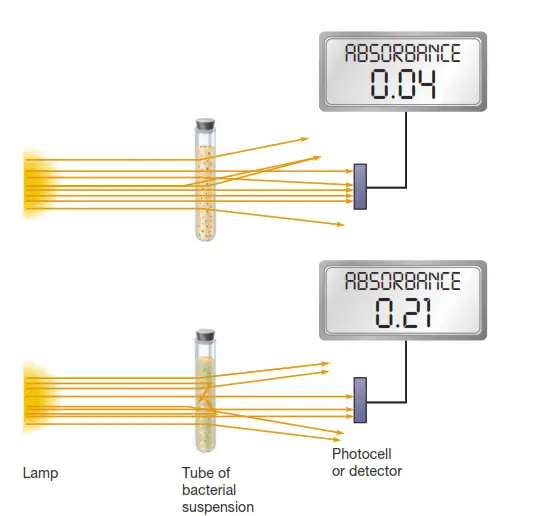
b-3- Flow cytometry technique :
It consists of measuring one or more specific parameters of an isolated cell, driven by a liquid flow. This technique is commonly applied in hematology. It is still being evaluated in microbiology.
c- Chemical markers
- This is the determination of proteins, DNA, ATP, peptidoglycan..
3- Bacterial Growth Kinetics :
The study of bacterial growth over time or growth kinetics can be represented on a graph by plotting :
- On the ordinate, the values of the log of the D.O of the culture medium;
- On the abscissa, the time.
The growth curve obtained then shows 6 phases:
- Latency phase: This is the phase of adaptation of bacteria to their culture medium. There is no bacterial multiplication during this phase. It corresponds to the start of the enzymatic systems of the bacteria.
- Acceleration phase: during which the generation time is shortened to reach the value characteristic of the bacterial species studied.
- Exponential growth phase: The growth rate reaches the maximum value. There is a doubling of the population at regular time intervals (doubling of the population every 20 minutes for E.coli ).
- Slowdown phase: Growth rate gradually decreases, generation time lengthens.
- Stationary phase: The bacterial mass is maximal. The new generations balance out the old bacteria that lyse.
- Decline phase: The bacterial mass decreases due to the accelerated lysis of the bacteria. This is linked to a depletion of nutrients, a reduction of oxygen, an accumulation of waste. The generation time is getting longer and longer, creating an imbalance between the new generations of bacteria (increasingly rare) and the old bacteria, which are dying in greater numbers.
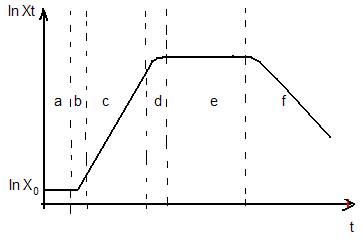
4- Growth curve changes :
a- Continuous growth:
The growth curve is that obtained for a bacterial culture in non-renewed medium. It is possible with tricks to obtain a bacterial culture maintained for a very long time in the exponential growth phase: This is called continuous growth, obtained by a regular supply of new nutrient medium and extraction of an equivalent quantity of old environment. These methods are commonly used in industry to obtain bacterial bodies of the same age (preparation of bacterial vaccines), or bacterial metabolites (vitamins), bacterial toxins (preparation of toxoids) in large quantities.
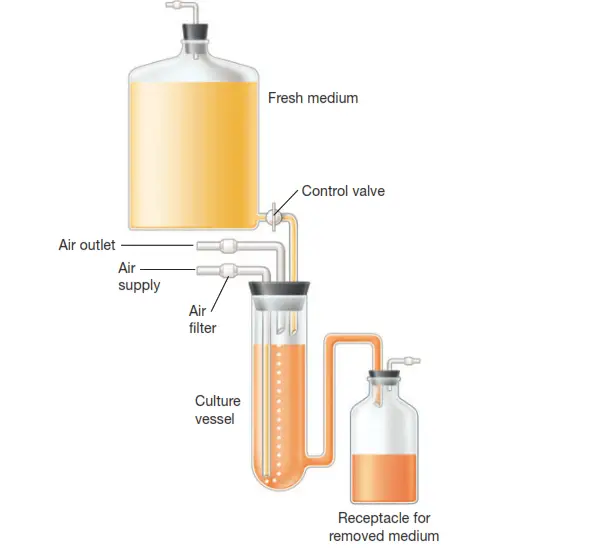
A chemostat is constructed such that the rate at which sterile medium is introduced into a culture vessel is the same as the rate at which medium containing microorganisms is removed
b- The diauxie:
In a synthetic medium, when the bacteria are provided with 2 carbonaceous substrates (limiting foods), 2 growth modes can be ensured:
- A normal growth curve, as if only one limiting substrate was given.
- A two-phase curve, characterized by an initial exponential growth, followed by a plateau and then a second exponential phase following a more or less pronounced intermediate latency phase.
Cause: during growth, one of the substrates is used first until exhaustion before the second substrate is assimilated in turn.